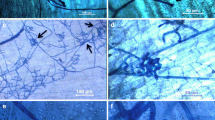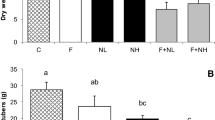Abstract
Field experiments were conducted to determine whether a hypovirulent, anastomosis group (AG) 3 isolate (Rhs 1A1) of R. solani could control rhizoctonia disease of potato caused by a virulent AG-3 isolate (Rhs 27). A uniform amount of Rhs 1A1, Rhs 27, or both was applied to formaldehyde-disinfected potato seed tubers at planting. In plots inoculated with Rhs 1A1 and Rhs 27, the area of infected stem tissue was significantly (P = 0.05) reduced by 56% as compared with that of plots inoculated with Rhs 27 alone. The number of stolons per plant was decreased by isolate Rhs 27 to one-half that of the uninoculated control, but remained unchanged in plots treated with both Rhs 1A1 and Rhs 27. The type of inoculum did not affect the percentage of infected stems or stolons. Plants inoculated with Rhs 1A1 alone exhibited a significantly (P = 0.05) greater growth response, expressed as a 4-fold increase in the dry weight of stolons, a 1.7-fold increase in the dry weight of stems, and reached full bloom approximately one week earlier than their respective control. Tuber yield increases associated with Rhs 1Al-treated plots were not statistically significant. When untreated seed tubers bearing natural inoculum (sclerotia) of R. solani were used, Rhs 1A1 failed to reduce disease severity or sig-nificantly stimulate plant growth.
Similar content being viewed by others
Literature Cited
Anagnostakis, S.L. and R.A. Jaynes. 1973. Chestnut blight control: Use of hypovirulent cultures. Plant Dis Reptr 27:225–226.
Anderson, N.A. 1982. The genetics and pathology ofRhizoctonia solani. Ann Rev Phytopathol 20:329–47.
Bandy, B.P., S.S. Leach and S.M. Tavantzis. 1988. Anastomosis group 3 is the major causeof Rhizoctonia disease of potato in Maine. Plant Disease 72:596–598.
Bandy, B.P., D.H. Zanzingerand S.M. Tavantzis. 1984. Isolation of anastomosis group 5 ofRhizoctonia solani from potato field soils in Maine. Phytopathology 74:1220–1224.
Campbell, R., E.I. Newman, R.A. Lawley and R Christie. 1982. Relationship of aRhizoctonia species and grassland plants. Trans Br Mycol Soc 79:123–127.
Castanho, B. and E.E. Butler. 1978a.Rhizoctonia decline: A degenerative disease ofRhizoctonia solani. Phytopathology 68:1505–1510.
Castanho, B. and E.E. Butler. 1978b.Rhizoctonia decline: studies on hypovirulence and potential use in biological control. Phytopathology 68:1511–1514.
Chamberlain, V.K. and R.L. Wain. 1971. Studies on plant growth-regulating substances. XXXIII. The influence of ring substituents on the plant growth-regulating activity of phenylacetic acid. Ann Appl Biol 69:65–72.
Elliston, J.E. 1982. Hypovirulence. Adv Plant Pathol 1:1–33.
Frank, J.A. 1978. TheRhizoctonia disease of potatoes in Maine. Am Potato J 55:59.
Frank, J.A. 1981.Rhizoctonia canker (black scurf). Pages 52–54In: Compendium of Potato Diseases. W.J. Hooker, Ed. American Phytopathological Society, St. Paul, MN. 125 pp.
Frank, J.A. and S.K. Francis. 1976. The effect of aRhizoctonia solani phytotoxin on potatoes. Can J Bot 54:2536–2540.
Frank, J.A., S.S. Leach and R.E. Webb. 1976. Evaluation of potato clone reaction toRhizoctonia solani. Plant Dis Rep 60:910–912.
Grente, J. and S. Berthelay-Sauret. 1979. Biological control of chestnut blight it; France. Pages 30–37In: Proceedings of the American Chestnut Symposium. W.L. McDonald, F.L. Chech, J. Luchokand C. Smith, Eds. West Virginia Univ. Press, Morgantown.
Haselwontder, K. and D.J. Read. 1980. Fungal association of roots of dominant and subdominant plants in high alpine vegetation systems with special reference to mycorrhiza. Oecologia, 45:57–62.
Ichielevich-Auster, M., B. Sneh, Y. Koltin and I. Barash. 1985. Suppression of damping-off caused byRhizoctonia species by a nonpathogenic isolate ofR. solani. Phytopathology 75:1080–1084.
Sneh, B., M. Zeidan, M. Ichielevich-Auster, I. Barash and Y. Koltin. 1986. Increased growth responses induced by a nonpathogenicRhizoctonia solani. Can J Bot 64:2372–2378.
Tavantzis, S.M., B.L. Perkins, R.J. Bushway and B.E Bandy. 1989. Correlation betweenin vitro synthesis of phenylacetic acid and virulence inRhizoctonia solani. (Abstr.) Phytopathology (In Press).
Van Alfen, N.K., R.A. Jaynes, S.L. Anagnostakis, and P.R. Day. 1975. Chestnut blight: Biological control by transmissible hypovirulence inEndothia parasitica. Science 189:890–891.
Warcup, J.H. 1985. PathogenicRhizoctonia and orchids. Pages 69–70In: Ecology and management of soil-borne plant pathogens. C.A. Parker, A.D. Rovira, K.J. Moore, P.T.W. Wong and J.E Kollmorgen, Eds. The American Phytopathological Society, St. Paul, MN.
Williams, P.G. 1985. Orchidaceous rhizoctonias in pot cultures of vesicular-arbuscular mycorrhizal fungi. Can J Bot 63:1329–1333.
Author information
Authors and Affiliations
Additional information
Maine Agricultural Experiment Station Journal Series No. 1420, supported in part by USDA Competitive Research Grant 84-CRCR-l-1430.
Rights and permissions
About this article
Cite this article
Bandy, B.R., Tavantzis, S.M. Effect of hypovirulent rhizoctonia solani on rhizoctonia disease, growth, and development of potato plants. American Potato Journal 67, 189–199 (1990). https://doi.org/10.1007/BF02987071
Accepted:
Issue Date:
DOI: https://doi.org/10.1007/BF02987071




